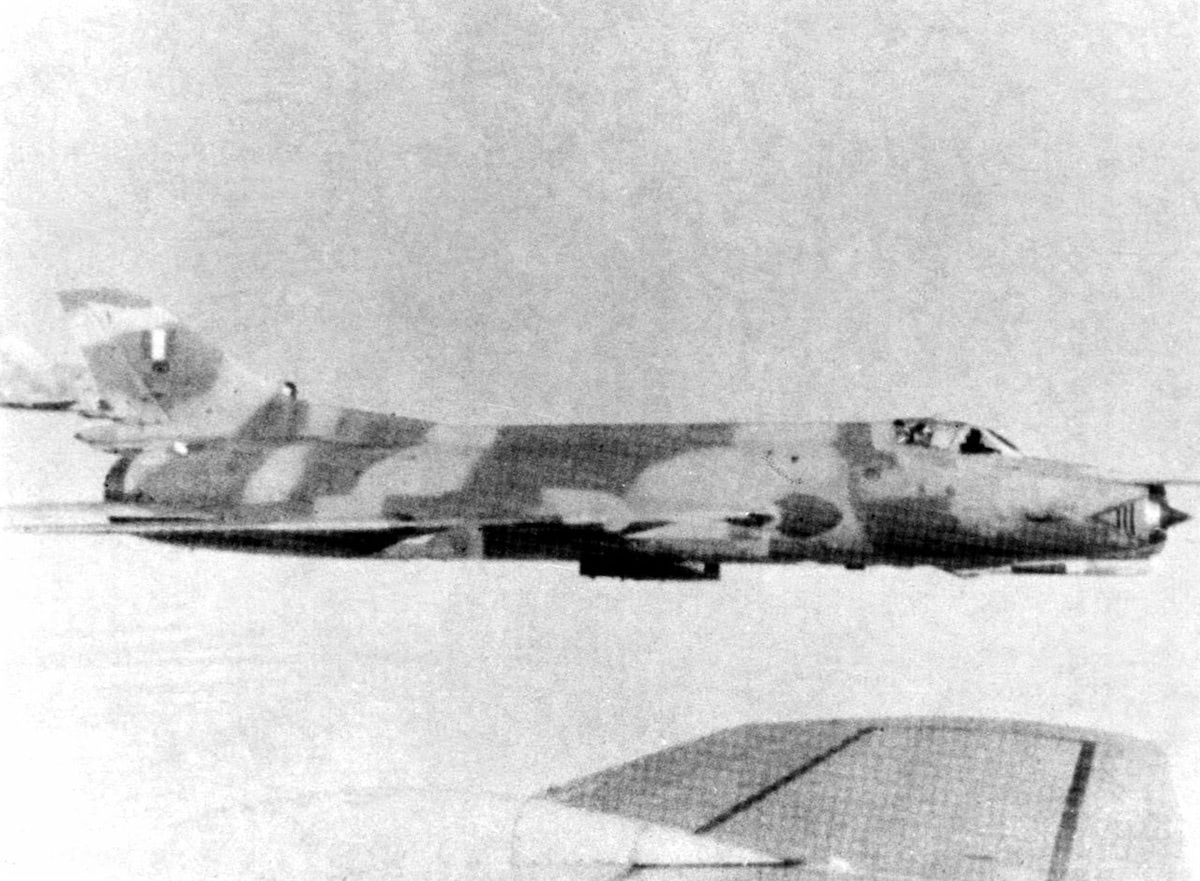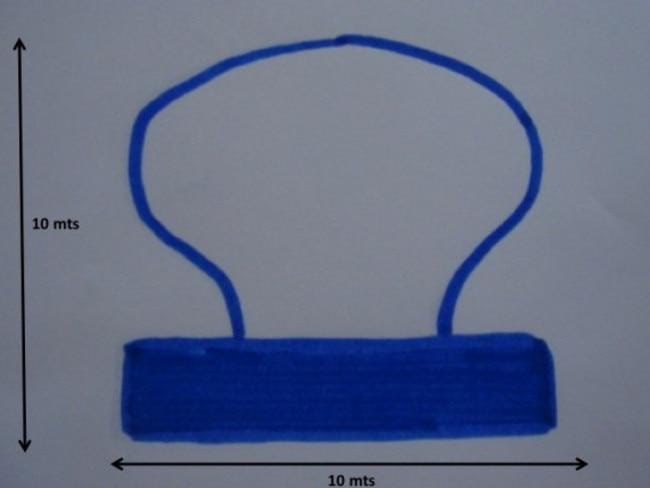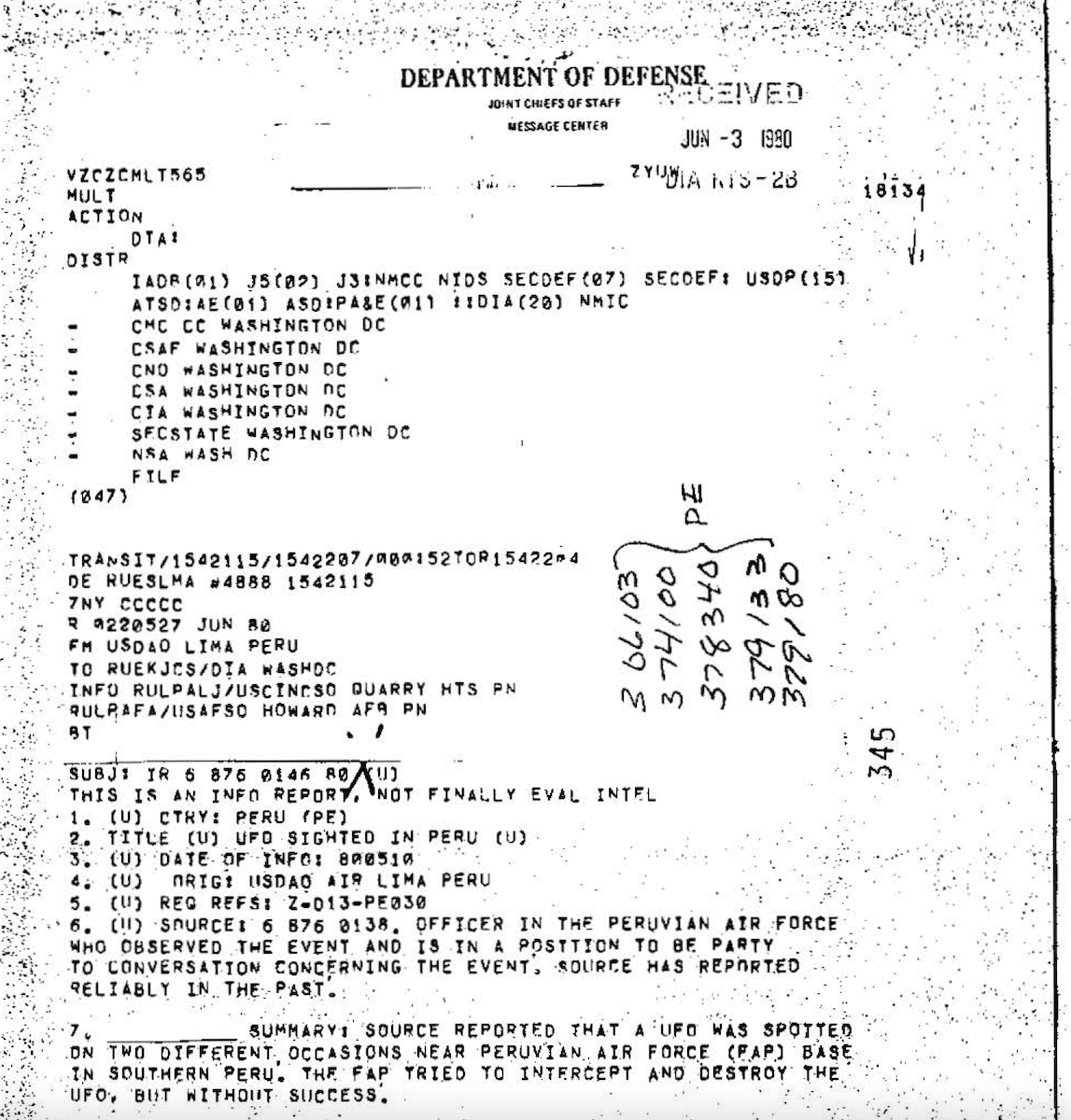Summary

The Arequipa Unidentified Aerial Phenomena (UAP) incident involved a Peruvian Air Force pilot, named Lieutenant Óscar Santa María Huertas, who on April 11, 1980 intercepted and fired at an unknown light-bulb shaped object¹ situated in the skies above La Joya Air Force Base.
Huertas in his Soviet Union era Sukhoi-22 fired at the UAP on four separate occasions. According to Huertas’s testimony, when first firing on the unknown object, it appeared to absorb his weapons. On the other three occasions the UAP moved away just when Huertas locked onto the object and was about to fire.
Huertas was unable to successfully bring the UAP down and the object remained stationary in the sky for two hours after Huertas returned to the base.

Incident Details
On the morning of April 11, 1980, 23-year-old² Óscar Santa María Huertas, a Peruvian Air Force Lieutenant, prepared for daily exercises at the La Joya Air Force Base, where approximately 1,800 military personnel and civilians were present at the time. Although in his early twenties, Huertas had been recognised for his achievements, writing:
‘At twenty I was selected to test-fly Peru’s newest supersonic Sukhoi jet. Having won quite a few trophies as a pilot, I was also known as a top aerial marksman with great skill at shooting from the air.’³
Huertas has stated that those people present at the base saw a stationary object in the sky which looked like a balloon. The UAP was about three miles in distance from the base and approximately 1800 ft in altitude. The unknown object was described as luminous whilst hovering above, as it reflected the Sun.
Huertas’s unit commander ordered him to intercept the UAP with his Sukhoi-22 fighter and “shoot down"⁴ the spherical object, as it was in restricted airspace without clearance, causing concerns that it could be a foreign espionage craft. Adding to such suspicions, the UAP did not respond to any communications. At the time Huertas believed it was a balloon.
In author Leslie Kean’s book, ‘UFOs: Generals, Pilots, and Government Officials Go on the Record’⁵, Huertas, who retired as a Colonel explained⁶:
‘This ‘balloon’ was in restricted air space without authorisation, representing a grave challenge to national sovereignty.⁷’
As Huertas approached the UAP, he fired 64 34mm shells at it. Some projectiles fell towards the ground whilst others hit the UAP directly without impact. Huertas explained how the projectiles did not bounce off the unknown object and has since speculated that the object may have absorbed the shells.⁸
Huertas has explained how the cone-shaped wall of fire targeted from his Sukhoi-22 at the UAP would, according to Huertas, normally “obliterate”⁹ anything in its path.
According to Huertas, after firing his weapons, the object began to ascend and shot rapidly skywards away from the base. This prompted Huerta to activate the Sukhoi-22’s afterburner to give chase 500m behind. As they reached the city of Camana, 84km from the base, the UAP came to a sudden stop, forcing Huertas, who was at 30,000 ft¹⁰ in altitude, to veer to the side.
Huertas then manoeuvred his Sukhoi-22 to a higher altitude, so he could attack the UAP from above. But just when he locked onto his target and was ready to fire, the object made a straight vertical climb to evade attack, leaving him underneath the UAP.
On two occasions during the engagement, Huertas had the object locked on target whilst it was stationary – but both times the object moved away at the very last moment before he could open fire, evading any attack.
Huertas then pulled his Sukhoi-22 up at full thrust to get above the object, but the UAP began to ascend, shadowing and almost parallel to Huertas’s craft. When Huertas reached 63,000 ft, he stopped climbing, as this height was above his plane’s specifications.

At this point, Huertas has recalled how he came to within about 300 ft of the unknown object and was able to describe its appearance:
‘I was startled to see that the ‘balloon’ was not a balloon at all. It was an object that measured about 10 metres in diameter with a shiny dome on top that was cream-coloured, similar to a light bulb cut in half,” he wrote in Kean’s book.’¹¹
He added:
‘The bottom was a wider circular base, a silver colour, and looked like some kind of metal. It lacked all the typical components of aircraft. It had no wings, propulsion jets, exhausts, windows, antennae, and so forth. It had no visible propulsion system.’
At that moment, Huertas realised the object was not a spy craft and that it was “something totally unknown”¹². At this point Huertas began to get scared. He was almost out of fuel, so could no longer attack, manoeuvre his craft, or even make a high-speed escape. Huertas radioed base, requesting for another plane to come and assist him. But officers at the base refused his request, stating the UAP was too high, and ordered him to return.
Due to a lack of fuel, Huertas glided his Sukhoi-22 back to base, zigzagging as he did so, so that his plane was harder to target. When doing so, Huertas kept his eyes on the rear-view mirrors, hoping the unknown object did not chase him, which it did not.
After Huertas landed, the object remained in the place he left it for a further two hours, ‘visible to everyone on the base while it reflected in the sun’.¹³
Incident Reported To United States Department of Defense
The incident was reported in a June 3, 1980 document from the U.S. Department of Defense Joint Chiefs of Staff Message Center, released years later by the Defense Intelligence Agency (DIA) under the Freedom of Information Act (FOIA).¹⁴
The document includes a discrepancy and doesn’t refer to April 11, as the date of the incident. Instead, it refers to ‘the morning hours of 9 May’ when a Sukhoi-22 fired at the UAP at ‘close range without causing any apparent damage’.
The document also refers to a second sighting of UAP / a ‘vehicle’ in vicinity of the same base in the early evening hours of May 9, stating:
‘The second sighting was s[d]uring hours of darkness. The vehicle was lighted. Again an SU-22 was scrambled, but the vehicle out-ran the aircraft.’¹⁵

La Joya Air Force Base, Peru
The La Joya Air Force Base is in the agricultural district of La Joya in the Arequipa region of Peru, and located 1,000km south of the Peruvian capital, Lima. It has been referred to as a ‘fairly secretive air base’. In 1980, the year of the UAP incident, Peru was the only country in South America with ‘few’ Soviet-made fighter jets.¹⁶
Was Huertas The Only Military Pilot To Have Fired And Struck UAP?
Huertas has written about his apparent status as being the first pilot to shoot at UAP:
“I find myself in the unique position, at least for the moment, and as far as I know, of being the only military pilot in the world who has actually fired a weapon and struck a UFO. It still gives me chills to think about it.”
Other similar incidents include the Tehran UAP incident of 1976, where an unknown object was intercepted by the Imperial Iranian Air Force. Two Iranian F-4 aircraft intercepted the UAP. Once close to the object, the equipment of both aircraft appeared to malfunction. One of the pilots was prepared to fire at the object until he lost power to his weapons control system, preventing him from using his missile.¹⁷
In 1957, U.S. pilot, Dr. Milton Torres was 10 seconds from firing his missiles at the UAP over Eastern England. But before he could fire from his F-86D interceptor, the object appeared to travel at extraordinary speed and away from danger.¹⁸
In his book ‘Need to Know’ author and UAP researcher, Timothy Good, has claimed that a French pilot named Jean Kisling, serving with the United States Air Force, was the first to shoot at UAP in 1945.¹
Kisling at first believed the unknown objects to be balloons. He recounted:
“On board my P47 I climb up to reach my goal, surprisingly, between my device and these balloons the distance remains unchanged!
“Arrived at nearly 55,000 feet, despite the difficulties of piloting - cold and altitude - I managed to release a long burst of my 8 machine guns caliber 12.7 mm in the direction of the balloons.
“To my great surprise, these balloons then transform into flying saucers, move away and disappear at an exceptional speed, leaving behind them traces similar to those of jet planes at high altitude.”²⁰
Endnotes
1. Chung, Frank (30/12/2015) ‘The only man to ever shoot at a UFO’, news.com.au, here Oscar Santa Maria Huerta: Pilot fires on UFO in only documented case | news.com.au — Australia’s leading news site
2. More on Chilean captain's UFO book - Openminds.tv – referencing Amazon.com: UFOs: Generals, Pilots, and Government Officials Go on the Record: 8601300189888: Leslie Kean, John Podesta: Books
3. Óscar Santa María Huertas recalls his UAP encounter at the National Press Club in 2007 (3) Comandante FAP Oscar Santa Maria Huertas en el National Press Club 2007 - YouTube
6. Óscar Santa María Huertas recalls his UAP encounter at the National Press Club in 2007 (3) Comandante FAP Oscar Santa Maria Huertas en el National Press Club 2007 - YouTube
7. Óscar Santa María Huertas recalls his UAP encounter at the National Press Club in 2007 (3) Comandante FAP Oscar Santa Maria Huertas en el National Press Club 2007 - YouTube
8. Óscar Santa María Huertas recalls his UAP encounter at the National Press Club in 2007 (3) Comandante FAP Oscar Santa Maria Huertas en el National Press Club 2007 - YouTube
10. Óscar Santa María Huertas recalls his UAP encounter at the National Press Club in 2007 (3) Comandante FAP Oscar Santa Maria Huertas en el National Press Club 2007 - YouTube
15. Iranian UAP incident 1976 Tehran UFO incident - What happened? | UfoSightingsToday
16. Milton Torres incident Milton Torres, F86D pilot, ordered to shoot a UFO with rockets after 50 years - The Portugal News
17. Need to Know A Need to Know - Google Books